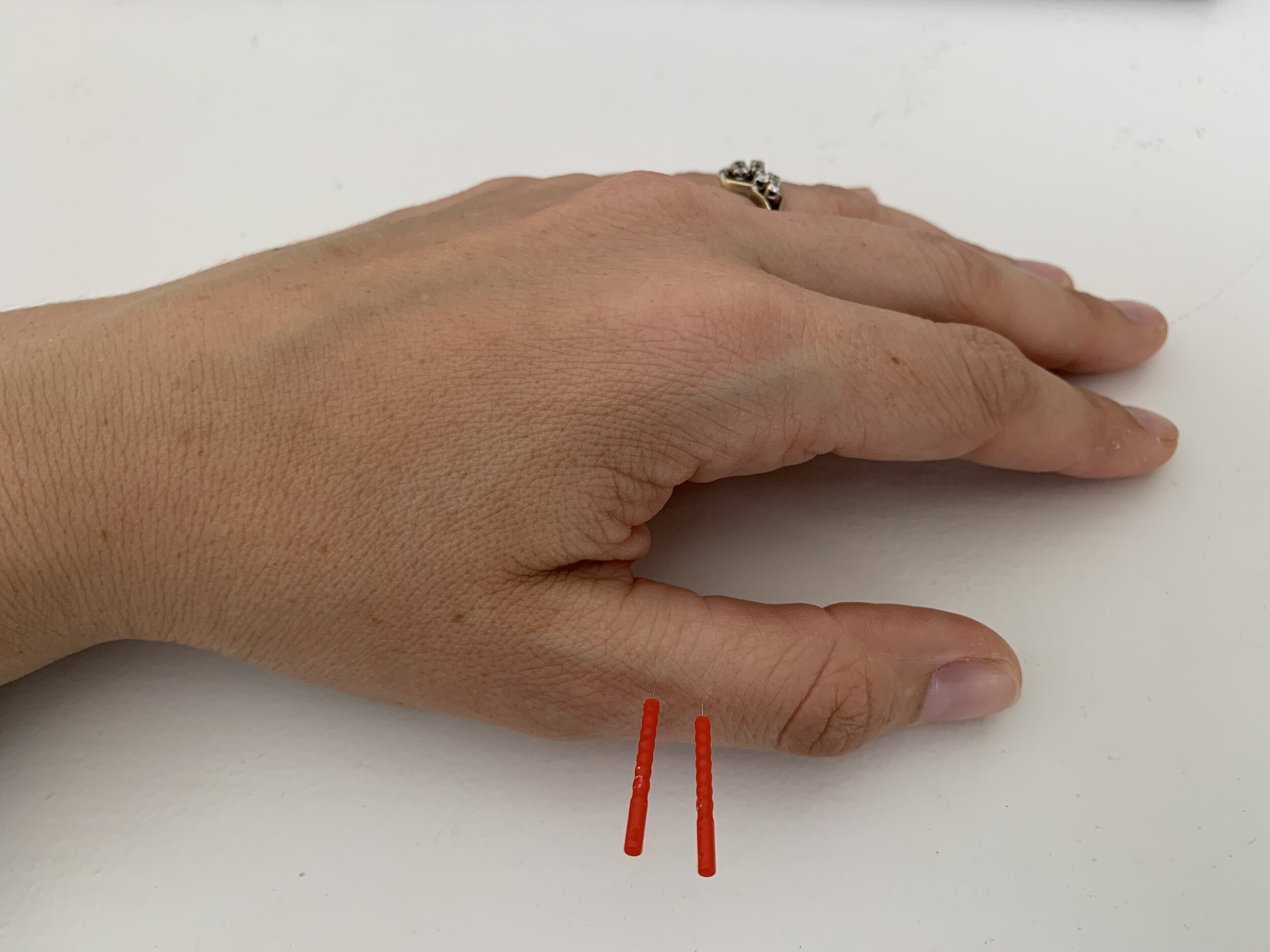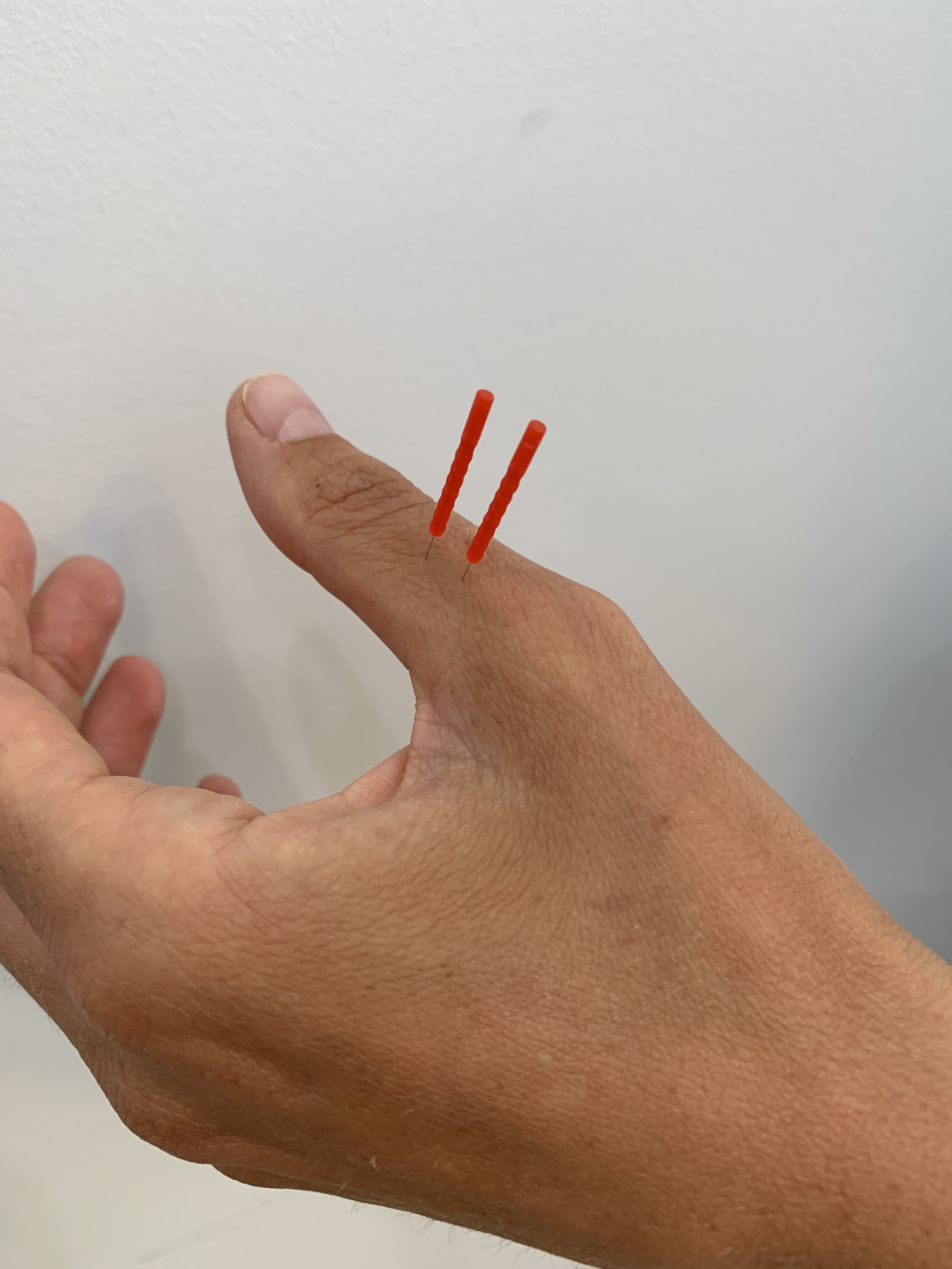For acupuncture students - clearing clotting with acupuncture
THE USE OF FU KE TO RESOLVE ENDOMETRIAL CLOTTING
Master Tung’s acupuncture point, Fu Ke 11.24 (meaning ‘gynaecological point’) is well known amongst Tung acupuncturists for its affinity with the uterus. It is indicated for a variety of gynaecological conditions, such as dysmenorrhea, amenorrhea, heavy menstrual bleeding, uterine fibroids and infertility (McCann & Ross, 2015; Johnson & Renaud, 2019).
Fu Ke is a 2 point group, located on the dorsal proximal phalanx of the thumb near the ulnar border of the phalangeal bone (McCann & Ross, 2015).
It is very comfortably needled using thin .16 x 15mm needles, in a technique called ‘shaving the bone’, where the needle is inserted perpendicularly to run alongside the phalangeal bone.
In my experience, this point has a very interesting function, and when timed appropriately to fit with the menstrual cycle, can be very effective to resolve endometrial clotting.
Clotting in the lining can cause symptoms such as painful and irregular periods, mid-cycle bleeding, extended days of menstruation, as well as periods where the blood flow starts and stops. Clotting can also cause the period to be heavy, because the uterus is contracting strongly in an effort to push these clots out. These strong contractions can cause pain and very heavy bleeding where the patient often sees large clots. For this purpose, Steven Clavey uses Yi Mu Cao in an herbal formula, which is invaluable for its ability to promote uterine contractions to eliminate clotting.
Fu Ke can be used in a similar way as Yi Mu Cao, when applied at the start of menstruation. The point strongly redirects and regulates blood flow to the uterus, which will not only ease pain, it will also facilitate uterine contractions to resolve clotting. By doing so, the menstrual flow increases, and the patient may pass large clots afterwards. This effect can only be gained on Days 1 or 2 of a standard menstrual window. It is essential to warn your patient before starting the treatment that this may happen. If a woman is already passing clots the size of a 50-cent piece, it is not uncommon that she will then pass clots the size of her fist after we do this style of treatment. As the patient is prepped for what to expect, it is rarely an issue.
Where this point must be used with caution is for women with heavy bleeding. By facilitating uterine contractions, the bleeding will also increase. Differential diagnosis is key here. If a woman has heavy bleeding and pain caused by Spleen Yang deficiency alone, this point is not appropriate for use during her menstruation. It will increase bleeding, further damaging an already weakened Spleen. However, for patients where clotting is the primary pattern (discernible, for instance, by prominent sublingual veins under the tongue, a choppy pulse, and substantial clots in the menses), this point is irreplaceable for its functionality.
For these patients with clotting causing heavy bleeding, Fu Ke can be used alongside points such as Yin Bai (Sp1), Da Dun (Lv1) and Bai Hui (Du20) on Days 1 or 2. You will likely find that if the patient has pain, it is substantially relieved after use of these needles. Because of its affinity with the uterus, Fu Ke is excellent for central lower abdominal pain. If pain continues, Ling Gu 22.05 may be selected, especially for pain in the lower back. As always, the point selection must fit with your differential diagnoses. There is no one set of points that will work for all cases. The patient should leave your clinic feeling comfortable. She also needs to understand that pain can then return again when the clots are being eliminated. I generally find this effect starts a few hours after the acupuncture treatment. I often encourage women to take that day (or the next day if the session is in the afternoon) off from work, so that they can be home. The flow will become heavier, she may pass very large clots, and in doing so, her pain will increase. This is what I call a ‘functional pain’. We can expect and warn the patient that it will occur, and it is part of the treatment process. It is a means to an end. Once clots are eliminated, there will not be more pain and we have treated the root cause of the issue.
These patients require a follow up appointment 1-3 days (ideally 1-2 days) after the use of Fu Ke. This second session will focus on astringing the heavy blood flow. Typically, in this session, I select points such as Bai Hui (Du20), Yin Bai (Sp1), Da Dun (Lv1) and Zu San Li (St36), with the use of moxa on Sp1 and Ren4 where appropriate. After this session, the heavy bleeding should subside. Ideally a supplementing herbal formula is then also given, to help restore and rebuild the resources that were lost. Timing this session shortly afterwards is crucial. Waiting any longer than 3 days will put the patient at risk of depletion.
The patient can feel worn out by the process, but with appropriate management, this treatment has profound ramifications. Usually this session only needs to be applied over 1-3 menstruations, even for very severe blood stasis presentations. After this, the clotting is usually resolved, so the patient is much less likely to suffer from heavy menstruation or pain. I have had success using this approach to work with severe pelvic pain in patients with endometriosis and adenomyosis. Careful use of this technique is also applicable to fertility patients, where clotting is preventing implantation. Communication with the patient, and management of timing of the sessions, including a follow up soon after use of Fu Ke, are essential.
Bibliography:
McCann, Henry and Ross, Hans-Georg. (2015) Practical Atlas of Tung’s Acupuncture. Publisher not specified.
Johnson, Susan and Renaud, Erin. (2019) Master Tung’s Magic Points. Magic Points Press.
LET’S CONNECT
Naomi Jankowski is a Chinese Medicine practitioner working in Melbourne, with special interest in the use of Tung acupuncture for pelvic pain management.




